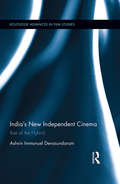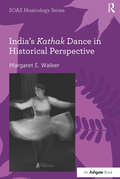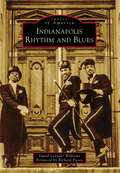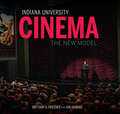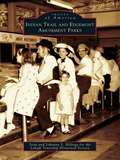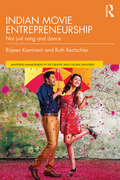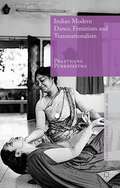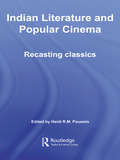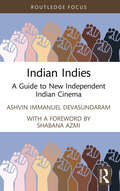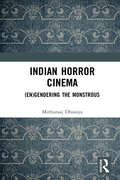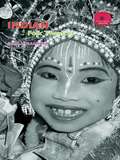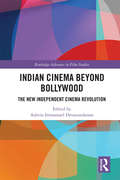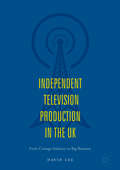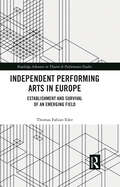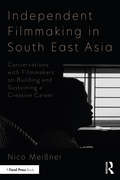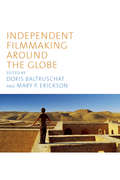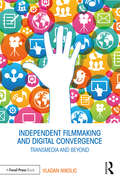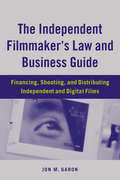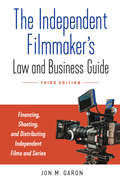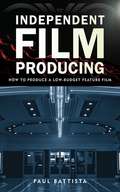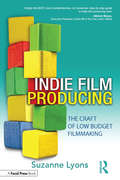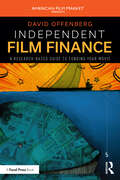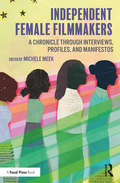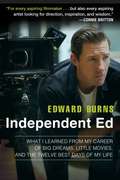- Table View
- List View
India's New Independent Cinema: Rise of the Hybrid (Routledge Advances in Film Studies)
by Ashvin Immanuel DevasundaramThis is the first-ever book on the rise of the new wave of independent Indian films that is revolutionising Indian cinema. Contemporary scholarship on Indian cinema so far has focused asymmetrically on Bollywood—India’s dominant cultural export. Reversing this trend, this book provides an in-depth examination of the burgeoning independent Indian film sector. It locates the new 'Indies' as a glocal hybrid film form—global in aesthetic and local in content. They critically engage with a diverse socio-political spectrum of ‘state of the nation’ stories; from farmer suicides, disenfranchised urban youth and migrant workers to monks turned anti-corporation animal rights agitators. This book provides comprehensive analyses of definitive Indie new wave films including Peepli Live (2010), Dhobi Ghat (2010), The Lunchbox (2013) and Ship of Theseus (2013). It explores how subversive Indies, such as polemical postmodern rap-musical Gandu (2010) transgress conventional notions of ‘traditional Indian values’, and collide with state censorship regulations. This timely and pioneering analysis shows how the new Indies have emerged from a middle space between India’s globalising present and traditional past. This book draws on in-depth interviews with directors, actors, academics and members of the Indian censor board, and is essential reading for anyone seeking an insight into a current Indian film phenomenon that could chart the future of Indian cinema.
India's Kathak Dance in Historical Perspective (SOAS Studies in Music)
by Margaret E. WalkerKathak, the classical dance of North India, combines virtuosic footwork and dazzling spins with subtle pantomime and soft gestures. As a global practice and one of India's cultural markers, kathak dance is often presented as heir to an ancient Hindu devotional tradition in which men called Kathakas danced and told stories in temples. The dance's repertoire and movement vocabulary, however, tell a different story of syncretic origins and hybrid history - it is a dance that is both Muslim and Hindu, both devotional and entertaining, and both male and female. Kathak's multiple roots can be found in rural theatre, embodied rhythmic repertoire, and courtesan performance practice, and its history is inextricable from the history of empire, colonialism, and independence in India. Through an analysis both broad and deep of primary and secondary sources, ethnography, iconography and current performance practice, Margaret Walker undertakes a critical approach to the history of kathak dance and presents new data about hereditary performing artists, gendered contexts and practices, and postcolonial cultural reclamation. The account that emerges places kathak and the Kathaks firmly into the living context of North Indian performing arts.
Indianapolis Rhythm and Blues (Images of America)
by David Leander WilliamsIndiana Avenue was traditionally the host to some of America's premier, world-renown entertainment icons in various genres. Along this winding, brightly lit thoroughfare were nightclubs, lounges, supper clubs, taverns, juke joints, and holes-in-the-wall that celebrated the best of the best in entertainment that America had to offer, from the 1920s on into the 1970s. On the bandstand at Denver Ferguson's Sunset Terrace Ballroom, the elegantly attired crooner Nat King Cole, in a sparkling blue silk suit, delivered his signature song "Mona Lisa." Nearby, B.B. King sang his 1973 down-home blues classic "To Know You is to Love You." At Tuffy Mitchell's Pink Poodle nightclub, "Moms" Mabley made the audience roar with laughter during her sidesplitting comedy routine. Indiana Avenue truly was the place to be for the best in entertainment.
Indiana University Cinema: The New Model (Well House Books)
by Brittany D. Friesner Jon VickersIn its first ten years, a small Midwestern cinema has attracted some of the most intriguing and groundbreaking filmmakers from around the world, screened the best in arthouse and repertory films, and presented innovative and unique cinematic experiences.Indiana University Cinema tells the story of how the cinema on the campus of Indiana University Bloomington grew into a vibrant, diverse, and thoughtfully curated cinematheque. Detailing its creation of a transformative cinematic experience throughout its inaugural decade, the IU Cinema has arguably become one of the best venues for watching movies in the country. Featuring 17 exclusive interviews with filmmakers and actors, as well as an afterword from Jonathan Banks (Breaking Bad and Better Call Saul), Indiana University Cinema, is a lavishly illustrated book that is sure to please everyone from the casual moviegoer to the most passionate cinephile.
Indian Trail and Edgemont Amusement Parks (Images of America)
by Lehigh Township Historical Society Johanna S. Billings Sean BillingsIndian Trail and Edgemont Amusement Parks highlights the history of two legendary amusement parks in Lehigh Township. Unique images cover Indian Trail Park from its founding by Samuel and William Solliday in 1929 to its closing in 1984. Photographs of Edgemont Park recall its days as a trolley park, started by the Blue Ridge Traction Company. These images are sure to bring back memories of the rides, games, and thrills that kept people coming back year after year.
Indian Movie Entrepreneurship: Not just song and dance (Discovering the Creative Industries)
by Rajeev Kamineni Ruth RentschlerOne of the world’s most prolific creative industries, the Indian movie industry has received scant attention for its spirit of enterprise. Indian Movie Entrepreneurship addresses this omission. For many readers, it might come as a surprise that the Indian movie industry is not just Bollywood and that it has several regional clusters, which are just as vibrant, with a significant output. The authors begin by outlining the contours of Indian cinema and the different regional language hubs that form part of the larger picture. The reader is then offered a glimpse into the actual process of making a film from day zero to release day. The key players in the Indian movie ecosystem are analysed, with the central role of the producer highlighted. Concluding with a look into the future of the entrepreneurial process in the Indian movie industry, the authors illuminate the shifting parameters of distribution and exhibition. Appealing to those interested in understanding the entrepreneurial journey of the Indian movie industry, the book provides a sneak peek into the business landscape of India more broadly.
Indian Modern Dance, Feminism and Transnationalism
by Prarthana PurkayasthaThis book examines modern dance as a form of embodied resistance to political and cultural nationalism in India through the works of five selected modern dance makers: Rabindranath Tagore, Uday Shankar, Shanti Bardhan, Manjusri Chaki Sircar and Ranjabati Sircar.
Indian Literature and Popular Cinema: Recasting Classics (Routledge Contemporary South Asia Series)
by Heidi R.M.PauwelsThis book is about the popular cinema of North India ("Bollywood") and how it recasts literary classics. It addresses questions about the interface of film and literature, such as how Bollywood movies rework literary themes, offer different (broader or narrower) interpretations, shift plots, stories, and characters to accommodate the medium and the economics of the genre, sometimes even changing the way literature is read. This book addresses the socio-political implications of popular reinterpretations of "elite culture", exploring gender issues and the perceived "sexism" of the North Indian popular film and how that plays out when literature is reworked into film. Written by an international group of experts on Indian literature and film, the chapters in this book focus on these central questions, but also cover a wide range of literary works that have been adapted in film. Each part of the book discusses how a particular genre of literature has been "recast" into film. The individual chapters focus on comparisons and close studies of individual films or film songs inspired by "classics" of literature. The book will be of interest to those studying Indian film and literature and South Asian popular culture more generally.
Indian Indies: A Guide to New Independent Indian Cinema (Routledge Focus on Film Studies)
by Ashvin Immanuel DevasundaramThis book offers a concise and cutting-edge repository of essential information on new independent Indian films, which have orchestrated a recent renaissance in the Bollywood-dominated Indian cinema sphere. Spotlighting a specific timeline, from the Indies’ consolidated emergence in 2010 across a decade of their development, the book takes note of recent transformations in the Indian political, economic, cultural and social matrix and the concurrent release of unflinchingly interrogative and radically evocative films that traverse LGBTQ+ issues, female empowerment, caste discrimination, populist politics and religious violence. A combination of essential Indie-specific information and concise case studies makes this a must-have quick guide to the future torchbearers of Indian cinema for scholars, students, early career researchers and a global audience interested in intersecting aspects of cinema, culture, politics and society in contemporary India.
Indian Horror Cinema: (En)gendering the Monstrous
by Mithuraaj DhusiyaThis book studies the hitherto overlooked genre of horror cinema in India. It uncovers some unique and diverse themes that these films deal with, including the fear of the unknown, the supernatural, occult practices, communication with spirits of the deceased, ghosts, reincarnation, figures of vampires, zombies, witches and transmutations of human beings into non-human forms such as werewolves. It focusses on the construction of feminine and masculine subjectivities in select horror films across seven major languages – Hindi, Tamil, Telugu, Kannada, Bangla, Marathi and Malayalam. The author shows that the alienation of the body and bodily functions through the medium of the horror film serves to deconstruct stereotypes of caste, class, gender and anthropocentrism. Some riveting insights emerge thus, such as the masculinist undertow of the possession narrative and how complex structures of resistance accompany the anxieties of culture via the dread of laughter. This original account of Indian cinematic history is accessible yet strongly analytical and includes an exhaustive filmography. The book will interest scholars and researchers in film studies, media and cultural studies, art, popular culture and performance, literature, gender, sociology, South Asian studies, practitioners, filmmakers as well as cinephiles.
Indian Geography For IAS Prelims Competetive Exam
by Indic TrustThis is a compilation of questions answer of Indian Geography for Prelims Exam.
Indian Folk Theatres
by Julia HollanderIndian Folk Theatres is theatre anthropology as a lived experience, containing detailed accounts of recent folk theatre shows as well as historical and cultural context. It looks at folk theatre forms from three corners of the Indian subcontinent: Tamasha, song and dance entertainments from Maharastra Chhau, the lyrical dance theatre of Bihar Theru Koothu, satirical, ritualised epics from Tamil Nadu. The contrasting styles and contents are depicted with a strongly practical bias, harnessing expertise from practitioners, anthropologists and theatre scholars in India. Indian Folk Theatres makes these exceptionally versatile and up-beat theatre forms accessible to students and practitioners everywhere.
Indian Cinema Beyond Bollywood: The New Independent Cinema Revolution (Routledge Advances in Film Studies)
by Ashvin Immanuel DevasundaramThis is the first edited volume on new independent Indian cinema. It aims to be a comprehensive compendium of diverse theoretical, philosophical, epistemological and practice-based perspectives, featuring contributions from multidisciplinary scholars and practitioners across the world. This edited collection features analyses of cutting-edge new independent films and is conceived to serve as a beacon to guide future explorations into the burgeoning field of new Indian Cinema studies.
Independent Television Production in the UK: From Cottage Industry To Big Business
by David LeeThis book is the first authoritative account of the UK’s independent television production sector, following the creation of Channel 4 in 1982. It examines the rise of a global industry, increasingly interconnected through format development, distribution, ancillary sales and rights. Drawing on case studies, interviews and policy analysis; the author considers the cultural politics behind the growth of the ‘indies’, the labour conditions for workers in this sector, and some of the key television programmes that have been created within it. Filling an important gap in our understanding, this book constitutes a comprehensive account of this vital cultural industry for students, academics and researchers working in the areas of the cultural and creative industries, media and cultural policy and television studies.
Independent Performing Arts in Europe: Establishment and Survival of an Emerging Field (Routledge Advances in Theatre & Performance Studies)
by Thomas Fabian EderThis structural account of independent performing arts in Europe is complimented by an analysis of the challenging social situation within the field. This book presents a neo-institutional examination of the organizational field including its routines, scripts, and expectations which provides a contribution to theatre studies, labour studies, and to social and cultural policy studies as well as valuable context for current advocacy and governance. This study offers knowledge based on empirical data and thus a foundation that is equally important for scholarly discourse, cross-national learning, and scientifically based recommendations for action to administration, the cultural policy level, and associations alike. The book examines the independent performing arts communities in Austria, Bulgaria, the Czech Republic, Finland, Germany, Hungary, Iceland, Italy, Romania, Slovenia, Sweden and Switzerland.
Independent Filmmaking in South East Asia: Conversations with Filmmakers on Building and Sustaining a Creative Career
by Nico MeissnerFeaturing interviews with 27 award-winning and emerging filmmakers, this book is the first comprehensive look at independent filmmaking careers in South East Asia with never-before published insights into the lives and careers of some of the most influential filmmakers in one of the world’s most exciting screen production regions.Celebrating filmmaking in South East Asia, the interviews offer unique perspectives that highlight the various paths filmmakers have taken to establish and develop their independent filmmaking careers. Presenting filmmakers whose films span narrative, documentary and experimental genres, and from all ten South East Asian nations, the filmmakers in this collection include: Camera d’Or winner Anthony Chen Sundance Grand Jury Prize nominee Mouly Surya NETPAC Award Winner Sheron Dayoc Brunei’s first female director, Siti Kamaluddin Directors of the Wathann Festival, Thaiddhi and Thu Thu Shein Lao’s only female and first horror film director, Mattie Do Aimed at aspiring filmmakers with a focus on career building outside of global production hubs, Meißner has curated a collection of interviews that reflects the diversity and ambition of filmmaking in South East Asia. The book is accompanied by a companion website (www.southeastasianfilmcareers.com) that includes 27 micro-documentaries on the included filmmakers.
Independent Filmmaking Around the Globe
by Mary P. Erickson Doris BaltruschatIndependent Filmmaking around the Globe calls attention to the significant changes taking place in independent cinema today, as new production and distribution technology and shifting social dynamics make it more and more possible for independent filmmakers to produce films outside both the mainstream global film industry and their own national film systems. Identifying and analyzing the many complex forces that shape the production and distribution of feature films, the authors detail how independent filmmakers create work that reflects independent voices and challenges political, economic, and cultural constraints.With chapters on the under-explored cinemas of Greece, Turkey, Iraq, China, Malaysia, Peru, and West Africa, as well as traditional production centres such as the United States, the United Kingdom, Canada, and Australia, Independent Filmmaking around the Globe explores how contemporary independent filmmaking increasingly defines the global cinema of our time.
Independent Filmmaking and Digital Convergence: Transmedia and Beyond
by Vladan NikolicIndependent Filmmaking and Digital Convergence: Transmedia and Beyond offers a comprehensive analysis of the technological changes of the past few decades in independent film and media-making, and explores new strategies and practices in media production, exhibition and distribution for independent producers and content creators. The book examines how independent filmmaking concepts have merged with digital and online technologies to create new hybrid multi-platform content creations. It explores key questions like how to reach an audience at a time when media conglomerates and their products dominate the market, and simultaneously, there is an overabundance of content competing for viewer time. The book investigates what kind of stories we tell and why; how the audience has changed, and what their expectations are; what the various niche markets are for independent producers and creators in new media; and new models for media financing and distribution. The content found in this book: Bridges the gap between professional media-makers and amateurs by focusing on new and emerging media models and practices. Provides a holistic view of the new media landscape, and practical advice on producing content in the new multi-platform media environment. Demonstrates how to create financially sustainable models for independent producers and creators in a shifting and unstable environment, providing many challenges, but also opportunities for independents. The author's website (http://www.filmconvergence.com/) supports this book with case studies, news and updates.
The Independent Filmmaker's Law and Business Guide: Financing, Shooting, and Distributing Independent and Digital Films
by Jon M. GaronPreparing independent or guerrilla filmmakers for the legal, financial, and organizational questions that can doom a project if unanswered, this guide demystifies issues such as developing a concept, founding a film company, obtaining financing, securing locations, casting, shooting, granting screen credits, distributing, exhibiting, and marketing a film. Updated to include digital marketing and distribution strategies through YouTube or webisodes, it also anticipates the "problems" generated by a blockbuster hit: sound tracks, merchandizing, and licensing. Six appendices provide sample contracts, copyright forms and circulars, Writer's Guild of America definitions for writing credits, and studio contact information.
The Independent Filmmaker's Law and Business Guide: Financing, Shooting, and Distributing Independent Films and Series
by Jon M GaronToday's independent and digital filmmaking demands a clear guide to the business and legal aspects of the art. What fundraising options are available to a filmmaker? When should a filmmaker establish a corporation or limited liability company? How do screenwriters protect their work? What are a director's legal obligations to the producer, cast, and crew--and what are their obligations in return? This indispensable resource addresses the legal, financial, and organizational questions that an independent or guerrilla filmmaker must face, and the problems that will doom a project if left unanswered. It demystifies issues such as founding a film company, obtaining financing, preparing a budget, securing locations, shooting, granting screen credits, and distributing, exhibiting, and marketing a film. Newly updated and expanded, this third edition explores concepts such as integrating social media; crowd funding and nonprofit status funding; diversity, inclusion, and compensation equity; and distribution via streaming services. Six appendixes provide sample contracts, copyright circulars, Documentary Filmmakers' Statement of Best Practices in Fair Use, and more.
Independent Film Producing: How to Produce a Low-Budget Feature Film
by Paul BattistaThe number of independent films produced each year has almost doubled in the past decade, yet only a fraction will succeed. If, like many filmmakers, you have no industry connections, little to no experience, and a low or ultra-low budget, this outsider's guide will teach you what you need to know to produce a standout, high-quality film and get it into the right hands. Written by an entertainment lawyer and experienced director and producer, this handbook covers all the most essential business, legal, and practical aspects of producing on a low budget, including:Scripts Business plansCopyright issuesEquity and non-equity financingFund-raisingTax considerationsTalent recruitingSchedulingDistribution Securities laws Film festivals And more Also discussed are the new crowd funding laws covered by the JOBS Act, making this book a must-read for every indie producer in today's economy. If you want to produce a film that gets attention, pick up the book that is recommended or required reading at film, business, and law schools from UCLA to NYU. Whether you're a recent film school graduate or simply a Hollywood outsider, Independent Film Producing will be like having a best friend who is an experienced, well-connected insider.
Independent Film Producing: The Craft of Low Budget Filmmaking
by Suzanne LyonsIndie Film Producing explains the simple, basic, clear cut role of the independent film producer. Raising funds to do your dream project, producing award-winning films with a low budget, putting name actors on your indie film-it's all doable, and this book guides you through the entire process of being a successful producer with bonus tips on how to effortlessly maneuver through the sphere of social media marketing and fundraising tactics. Indie film producer Suzanne Lyons pilots you through the actual making of low budget films to show you how easy and fun it can be. Laid out in a step-by-step, A to Z, matter-of-fact style that shows how the producer's role can be easy, how to treat the film as a business, and especially how to avoid the painful pitfalls faced by so many producers, this book gives you the essential tools you need to make your film a success from the ground up. . Begins with the earliest stages of concept development, continues through production & post, and ultimately concludes with distribution . Shows you how to create a buzz for your film through marketing and promotions . Interviews with global producers who produced films using social media, festivals, apps, and more, give you real-world insight that can be applied to your own films . Website points you to a fantastic collection of resources that you'll need to produce your own films (http://booksite.focalpress.com/indiefilmproducing)
Independent Film Finance: A Research-Based Guide to Funding Your Movie (ISSN)
by David OffenbergFor aspiring producers and directors who need to learn film finance from the ground up, this revolutionary new book teaches the fundamentals, through the voices of more than 60 successful independent producers. Using a research and data-based approach, award-winning professor David Offenberg combines the wisdom of well-known and successful producers into one fun, easy-to-follow guide.Within, readers will learn how to talk to potential investors and what those financiers will expect from them in return. The book is also packed with informative anecdotes and examples to enrich each chapter and contextualize the film financing landscape. As the book progresses, equity, debt, revenue, profits, and their role in your movie will be explored. Accessible information about tax incentives and profit participations is included to help emerging filmmakers build out a workable financing plan. The book combines hard numbers and data sets, with direct guidance from successful producers, to construct a holistic overview on how you can turn your new-found financial knowledge into funding for your movie.This ground-breaking book is a must-read for any aspiring producer or director who wishes to gain an informed and easily digestible understanding of film finance.
Independent Female Filmmakers: A Chronicle through Interviews, Profiles, and Manifestos
by Michele MeekIndependent Female Filmmakers collects original and previously published essays, interviews, and manifestos from some of the most defining and groundbreaking independent female filmmakers of the last 40 years. Featuring material from the seminal magazine The Independent Film and Video Monthly—a leading publication for independent filmmakers for several decades—as well as new interviews conducted with the filmmakers, this book, edited by Michele Meek, presents a unique perspective into the ethnically and culturally diverse voices of women filmmakers whose films span narrative, documentary, and experimental genres and whose work remains integral to independent film history from the 1970s to the present. Independent Female Filmmakers also includes a biographical profile of each filmmaker, as well as an online resource with links to additonal interviews and a sample course syllabus. The filmmakers in this book include: • Lisa Cholodenko (High Art, The Kids Are All Right) • Martha Coolidge (Valley Girl, Real Genius, Introducing Dorothy Dandridge) • Cheryl Dunye (The Watermelon Woman, Stranger Inside) • Miranda July (The Future, Me And You And Everyone We Know) • Barbara Kopple (Harlan County USA, Wild Man Blues) • Maria Maggenti (The Incredibly True Adventures of Two Girls in Love) • Deepa Mehta (Fire, Earth, Water) • Trinh T. Minh-ha (Surname Viet, Given Name Nam, Night Passage) . . . and more!
Independent Ed
by Edward Burns Todd GoldAn entertaining and inspirational memoir by one of the most prominent practitioners and evangelists of independent filmmaking, and the acclaimed writer, director, and actor (Saving Private Ryan, Friends with Kids, Entourage) whose first film--The Brothers McMullen--has become an indie classic. <P><P> At the age of twenty-five, Ed Burns directed and produced his first film on a tiny $25,000 budget. The Brothers McMullen went on to win the Grand Jury Prize at the Sundance Film Festival in 1995, and established the working-class Irish American filmmaker as a talent to watch. In the twenty years since, Burns has made ten more films (She's the One, Sidewalks of New York, and The Fitzgerald Family Christmas), while also acting in big budget Hollywood movies (Saving Private Ryan), hit television shows (Entourage and Mob City), and pioneering a new distribution network for indie filmmakers online and with TV's On Demand service ("why open a film in twenty art houses when you can open in twenty million homes?").<P> Inspired by Burns's uncompromising success both behind and in front of the camera, students and aspiring filmmakers are always asking Burns for advice. In Independent Ed, Burns shares the story of his two remarkable decades in a fickle business where heat and box office receipts are often all that matter. He recounts stories of the lengths he has gone to to secure financing for his films, starting with The Brothers McMullen (he told his father: "Shooting was the twelve best days of my life"). How he found stars on their way up--including Jennifer Aniston and Cameron Diaz--to work in his films, and how he's adhered religiously to the dictum of writing what you know, working as if he was just starting out, and always "looking for the next twelve best days of my life."
